Abstract
Bibliometric analysis is of paramount importance in assessing the research impact wherein studies are ranked on the basis of citations received. It also brings out the excellent contribution of authors and journals in adding evidence for future research. This study aimed at evaluating the top 100 most cited articles on anterior communicating artery (ACoA) Aneurysms. Scopus database was searched using title specific search for the aneurysm of ACoA and top 100 most cited articles along with their authors, author IDs, affiliated institutions, countries and funding bodies were identified. Search yielded 841 articles and top 100 articles were identified to include in this analysis which secured 5615 citations. Citations per year was also calculated to minimize the risk of bias. Maximum citations by any article were 242. The United States was the major contributor to the number of articles while Kessler Institute for Rehabilitation became the highest contributing institution. DeLuca J proved to be a pioneer in this specialized area as he penned 6 studies being first author in 4 of them, making him the most frequent author. National Institutes of Health and the U.S. Department of Health and Human Services were the main funding bodies. Subcategory analysis revealed, 50% studies provided evidence for the treatment and the surgical outcome of the aneurysm. Studies like these can aid in better neurological and neurosurgical management in decision making of ACoA aneurysm.
Anterior communicating artery (ACoA) aneurysms are the most common intracranial aneurysms comprising 23-40% of all intracranial aneurysms. Owing to their anatomical and hemodynamic characteristics they have a high risk of rupture. ACoA aneurysms are distinct from other intracranial aneurysms in the fact that they originate from a pentacomplex of arteries comprising of the A1 segment of the bilateral anterior cerebral artery, the A2 segment of the bilateral anterior cerebral artery, and the ACoA itself. Due to their high risk of rupture, it’s really important to identify those risk factors. Nevertheless, rupture poses a lot of complications in the form of ACoA syndrome that includes behavioral and cognitive impairments. However, with advancements in medical care, a multitude of techniques have been developed to enhance the quality of life of patients.
This bibliometric analysis aims at providing an insight into the evidence base studies on ACoA aneurysms with the objective of easing the decision making process and aid in research. This is the very first comprehensive review of 100 most cited articles on ACoA aneurysms, to the best of our knowledge.
In July, 2021, Scopus Database was searched using title specific search for “Anterior Communicating Artery (ACoA) Aneurysm” studies included in this analysis were strictly in English language, specific to anterior communicating artery aneurysm. On the basis of citation number (CN), top 100 studies were identified and further analyzed to obtain the needed information including article title, author’s name, author’s ID, affiliations, specialty of the primary author, country of origin, journal of publication, year of publication, citations number, total number of citations, average citations per year and research funding details.
An enhanced review of top 100 articles was performed for the sub categorization of the studies into types and designs.
The title specific search yielded 841 articles discussing ACoA aneurysm. We included the top 100 most cited articles for evaluation which were published between 1956-2017 (Fig. 1). Maximum number of articles were reported between 1995-2010. Oldest article published by Logue et al. in 1956 was cited 37 times and stood 68th on the list. Whereas the most recent article published in 2017 by Colby et al. [10] secured 40 citations. In total, these studies received 5615 citations with lowest being 24 (article reported by Kaspera et al. [25] in 2014) and highest being 242, received by Alexander et al. On an average, each study had 56.15 citations. Article reported by Pool JL in 1962 had the minimum citations per year (CY) of 0.457 CY while the third most cited article by Castro et al. in 2009 had the maximum CY of 12.33. Top 10 articles with their title, number of citations (CN), citations per year (CY), author details and journal details are described in Table 1.
The articles included were published in 30 articles. Journal of Neurosurgery published the highest number of articles - 18 with maximum citation as well - 893. American Journal of Neuroradiology and Neurosurgery journals had reported 12 articles each with 664 and 609 citations respectively. Neurosurgery had the highest impact factor of 4.853. Top 5 journals with maximum number of articles, number of citations and their impact factor are depicted in Table 2.
The United States (USA) was the major contributor to the articles with 30 percent of the top 100 articles published. USA was succeeded by Japan and France with a contribution of 19 and 9 articles. Exact location of six articles couldn’t be identified. Country Wise contribution is illustrated in Fig. 2.
There wasn’t much variation seen at the institute level. The most affiliated institution was Kessler Institute for Rehabilitation with five studies conducted. Rutgers New Jersey Medical School and Tohoku University School of Medicine both reported four studies. Almost all the other institutions contributed one to two articles (Fig. 3).
DeLuca J affiliated to Kessler Institute for Rehabilitation, United States contributed the most to this field with six articles (Table 3). Three of his studies were amongst the top 10 most cited studies, suggesting his immense interest in the field whilst making him a pioneer too. He was the only author to have more than three publications after his name, whilst the contribution of the majority of the authors was limited to one to three articles.
Funding analysis (Fig. 4) revealed that 4 studies were funded each by the National Institutes of Health and U.S. Department of Health and Human Services while the National Institute of Neurological Disorders and Stroke funded 3 studies.
49 studies mentioned the treatment options for the management of ACoA as well as the post-surgical outcome. This was the maximally discussed subcategory. Other areas of research included clinical features (3%), Intraoperative variations (4%), Prediction of rupture of ACoA aneurysm (5%), Risk factors for the development (2%), Complications due to the rupture (21%), Hemodynamic pattern (9%) and overall management (6%) (Fig. 5).
This is the first ever detailed bibliometric analysis on anterior communicating artery aneurysm to the best of our knowledge. ACoA aneurysms are the most common intracranial aneurysms at a very high risk of rupture owing to their hemodynamic and anatomical features. 841 studies have been reported on various aspects of ACoA in total till date. Highest number of studies were done in the late 1990s and early 2000s. 3D computed tomography (CT) made it possible to assess the hemodynamic patterns and intraoperative anatomical variations and characteristics. Various surgical and non-surgical techniques with their outcomes have been discussed in detail.
With 242 citations, the study by Alexander et al. titled “Amnesia after anterior communicating artery aneurysm rupture” published in 1984 in Neurology mentioned the complications after the surgical repair of ruptured ACoA in 11 patients. Areas of interest included the medial septal nuclei, the paraventricular nucleus of the anterior hypothalamus, and the medial forebrain bundle [1].
The second most cited study with 159 citations was “Aneurysm of the anterior communicating artery: A review of neuroanatomical and neuropsychological sequelae” by DeLuca et al. in the year 1995 that assessed the complications due to rupture of ACoA. This study was funded by the U.S. Department of Education. This study presented a comprehensive review about the ACoA syndrome following rupture of the aneurysm characterized by amnesia, confabulation and personality changes. The neurobehavioral and neuroanatomical features of the same have been explained in this article in order to derive the best possible theory for amnesia despite the absence of any impairment in the diencephalon and mesial temporal lobe, areas of memory in the brain. As a conclusion, the basal forebrain has been implicated in amnestic syndrome. Confabulation was found to be associated with both frontal lobe and basal forebrain. Personality changes have been attributed to frontal lobe dysfunction, especially the medio-basal zones. The paper also speculates in detail the various aspects of memory functions [2].
148 citations were secured by the article titled “Hemodynamic patterns of anterior communicating artery aneurysms: A possible association with rupture” published in 2009 by Castro et al. making it the third most cited article. This study aimed at describing the various flow patterns along with their association to rupture of the aneurysm. To investigate the same, computation models were developed using 3D rotation angiography images. Small impaction zones, higher flow rates and elevated MWSS (maximum wall shear stress) were implicated as the potential risk factors for the rupture [6].
The oldest article was published in 1956 in the British Medical Journal by Logue et al. titled as “Surgery in spontaneous subarachnoid hemorrhage operative treatment of aneurysms on the anterior cerebral and anterior communicating artery”. This case report has received 37 citations [28].
The most recent study that described endovascular flow diversion as a treatment option for the ACoA aneurysm by Colby et al. was published in 2017. This was a cohort of 50 patients treated with pipeline embolization devices (PED). Success rate of 96% was achieved whilst 2 cases had to be aborted. Complete occlusion of the aneurysm was appreciated in majority of the cases, consequently, PED proved to be a novel treatment alternative to clipping and coiling [11].
Strongest risk factors included smoking (odds ratio, 2.036; 95% confidence interval, 1.277-3.245), asymmetry of A1 segments >40% (odds ratio, 2.524; 95% confidence interval, 1.275-4.996), pulsatility index (odds ratio, 0.004; 95% confidence interval, 0.000-0.124), and the angle between A1 and A2 segments ≤100° (odds ratio, 4.665; 95% confidence interval, 2.247-9.687) as speculated by Kaspera et al. [12].
9 studies brought into light about the hemodynamic features in relation to rupture, repair or treatment of the aneurysms. Placement of stents as a treatment has a drastic effect on the vascular geometry that can lead to hemodynamic stress [22]. Hemodynamic stress is affected by the waveform shape in the internal carotid artery [24]. The geometry of the aneurysm and the feeding vessels are the deciding factors for the same [5]. Smaller A1-A2 angle has been confirmed to have an association with ACoA aneurysms due to higher hemodynamic force distributions [26].
A knowledge about the potential variations can be beneficial in devising a proper neurosurgical plan and to prevent the postoperative deficits. Variety of anatomical characteristics have been recorded and presented by the neurosurgeons ranging from hypoplasia of the A1 segment of the anterior cerebral artery (ACA), median artery of corpus callosum, supplication of ACoA, duplication of A1 segment of ACA to azygos pericallosal artery [2,9].
This was the second most worked area with 21 studies in the field of ACoA aneurysm. Most common complications were personality, behavioural [15] and cognitive dysfunction1 [4,23] with amnestic syndrome being a frequent manifestation [1,4,33,41,42]. Risk in decision making was also reported by a study [30]. An interesting finding of hyponatremia in nearly 50% of the ruptured ACoA aneurysm cases is an area of research [8,37]. The ruptured aneurysm can also cause visual impairments, as exemplified by left homonymous hemianopia and right visual acuity disturbances in a case report due to penetration of the optic chiasm [11].
Clinical and morphological parameters can aid in the decision making for management of ACoA aneurysm. Anterior direction of the aneurysm dome, presence of bleb(s), and an aneurysm size ≥5 mm [29] as well as morphological features like aspect ratio >1.6 [44], flow angle and parent daughter angle predispose the aneurysms to rupture [27].
Half of the most cited studies focused on the treatment and surgical outcome of the aneurysm. There is a wide array of techniques for the treatment/repair of the ACoA aneurysm, namely Endovascular [3,7,10,16,32,38] Endoscopic clipping and coiling [17,19] stent assisted embolization [21,35,36] and microsurgical [39]. Fig. 6 depicts the evolution of treatment modalities for ACoA aneurysms over the years. Endovascular therapies can be achieved via devices like Woven EndoBridge (WEB), PED, HyperForm balloon remodeling or Guglielmi detachable coils (GDCs).
A surgical study conducted by Proust et al. introduced a criterion to opt for microsurgery or endovascular therapy as an approach to treat aneurysms. According to this study, it is advisable to prefer microsurgery when the fundi of aneurysm are directed anteriorly while for posteriorly directed fundi, endovascular packaging must be preferred [34].
There’s a possibility that some of the potential articles might have been excluded due to Title specific search criteria because of the absence of desired word. Since a few studies did not have an abstract, it was challenging to understand the subcategory of some studies solely from their title. Citations per year was calculated for each article in order to remove the risk of bias as earlier published studies tend to get time for securing more citation numbers.
This analysis paves a path for better decision making in the aneurysm of anterior communicating artery. The results of this study can aid in neurological as well as neurosurgical care and management. This study also applauds the works of the health professionals, institutions and journals in providing evidence to understand and comprehend ACoA aneurysms.
REFERENCES
1. Alexander MP, Freedman M. Amnesia after anterior communicating artery aneurysm rupture. Neurology. 1984; Jun. 34(6):752–7.

2. Aydin IH, Takçi E, Kadioğlu HH, Tüzün Y, Kayaoğlu CR, Barlas E. Vascular variations associated with anterior communicating artery aneurysms-an intraoperative study. Minim Invasive Neurosurg. 1997; Mar. 40(1):17–21.

3. Birknes JK, Hwang SK, Pandey AS, Cockroft K, Dyer AM, Benitez RP, et al. Feasibility and limitations of endovascular coil embolization of anterior communicating artery aneurysms: morphological considerations. Neurosurgery. 2006; Jul. 59(1):43–52.

4. Bondi MW, Kaszniak AW, Rapcsak SZ, Butters MA. Implicit and explicit memory following anterior communicating artery aneurysm rupture. Brain Cogn. 1993; Jul. 22(2):213–29.

5. Castro MA, Putman CM, Cebral JR. Patient-specific computational fluid dynamics modeling of anterior communicating artery aneurysms: a study of the sensitivity of intra-aneurysmal flow patterns to flow conditions in the carotid arteries. AJNR Am J Neuroradiol. 2006; Nov-Dec. 27(10):2061–8.
6. Castro MA, Putman CM, Sheridan MJ, Cebral JR. Hemodynamic patterns of anterior communicating artery aneurysms: a possible association with rupture. AJNR Am J Neuroradiol. 2009; Feb. 30(2):297–302.

7. Cekirge HS, Yavuz K, Geyik S, Saatci I. HyperForm balloon remodeling in the endovascular treatment of anterior cerebral, middle cerebral, and anterior communicating artery aneurysms: clinical and angiographic follow-up results in 800 consecutive patients. J Neurosurg. 2011; Apr. 114(4):944–53.

8. Chan JW, Hoyt WF, Ellis WG, Gress D. Pathogenesis of acute monocular blindness from leaking anterior communicating artery aneurysms: report of six cases. Neurology. 1997; Mar. 48(3):680–3.

9. Chowdhury D, Ahmed N, Chaurasia B, Barua KK. Azygos anterior cerebral artery aneurysm with subarachnoid hemorrhage. Neuroimmunology and Neuroinflammation. 2018; 5:39.

10. Colby GP, Bender MT, Lin LM, Beaty N, Huang J, Tamargo RJ, et al. Endovascular flow diversion for treatment of anterior communicating artery region cerebral aneurysms: a single-center cohort of 50 cases. J Neurointerv Surg. 2017; Jul. 9(7):679–85.

11. Penetration of the optic chiasm by a ruptured anterior communicating artery aneurysm. Case report. J Neurosurg. 1997; Aug. 87(2):324–6.
12. DeLuca J, Cicerone KD. Confabulation following aneurysm of the anterior communicating artery. Cortex. 1991; Sep. 27(3):417–23.

13. DeLuca J, Diamond BJ. Aneurysm of the anterior communicating artery: a review of neuroanatomical and neuropsychological sequelae. J Clin Exp Neuropsychol. 1995; Feb. 17(1):100–21.

14. DeLuca J. Cognitive dysfunction after aneurysm of the anterior communicating artery. J Clin Exp Neuropsychol. 1992; Nov. 14(6):924–34.

15. DeLuca J. Predicting neurobehavioral patterns following anterior communicating artery aneurysm. Cortex. 1993; Dec. 29(4):639–47.

16. Fang S, Brinjikji W, Murad MH, Kallmes DF, Cloft HJ, Lanzino G. Endovascular treatment of anterior communicating artery aneurysms: a systematic review and meta-analysis. AJNR Am J Neuroradiol. 2014; May. 35(5):943–7.

17. Froelich S, Cebula H, Debry C, Boyer P. Anterior communicating artery aneurysm clipped via an endoscopic endonasal approach: technical note. Neurosurgery. 2011; Jun. 68(2 Suppl Operative):310–6.

18. Gade A. Amnesia after operations on aneurysms of the anterior communicating artery. Surg Neurol. 1982; Jul. 18(1):46–9.

19. Gonzalez N, Sedrak M, Martin N, Vinuela F. Impact of anatomic features in the endovascular embolization of 181 anterior communicating artery aneurysms. Stroke. 2008; Oct. 39(10):2776–82.

20. Hernesniemi J, Dashti R, Lehecka M, Niemelä M, Rinne J, Lehto H, et al. Microneurosurgical management of anterior communicating artery aneurysms. Surg Neurol. 2008; Jul. 70(1):8–29.

21. Huang Q, Xu Y, Hong B, Zhao R, Zhao W, Liu J. Stent-assisted embolization of wide-neck anterior communicating artery aneurysms: review of 21 consecutive cases. AJNR Am J Neuroradiol. 2009; Sep. 30(8):1502–6.

22. Huang QH, Wu YF, Xu Y, Hong B, Zhang L, Liu JM. Vascular geometry change because of endovascular stent placement for anterior communicating artery aneurysms. AJNR Am J Neuroradiol. 2011; Oct. 32(9):1721–5.

23. Hütter BO, Gilsbach JM. Cognitive deficits after rupture and early repair of anterior communicating artery aneurysms. Acta Neurochir (Wien). 1992; 116(1):6–13.

24. Jou LD, Lee DH, Mawad ME. Cross-flow at the anterior communicating artery and its implication in cerebral aneurysm formation. J Biomech. 2010; Aug. 43(11):2189–95.

25. Kaspera W, Ładziński P, Larysz P, Hebda A, Ptaszkiewicz K, Kopera M, et al. Morphological, hemodynamic, and clinical independent risk factors for anterior communicating artery aneurysms. Stroke. 2014; Oct. 45(10):2906–11.

26. Kasuya H, Shimizu T, Nakaya K, Sasahara A, Hori T, Takakura K. Angles between A1 and A2 segments of the anterior cerebral artery visualized by three-dimensional computed tomographic angiography and association of anterior communicating artery aneurysms. Neurosurgery. 1999; Jul. 45(1):89–93.

27. Lin N, Ho A, Charoenvimolphan N, Frerichs KU, Day AL, Du R. Analysis of morphological parameters to differentiate rupture status in anterior communicating artery aneurysms. PLoS One. 2013; Nov. 8(11):e79635.

28. LOGUE V. Surgery in spontaneous subarachnoid haemorrhage; operative treatment of aneurysms on the anterior cerebral and anterior communicating artery. Br Med J. 1956; Mar. 1(4965):473–9.
29. Matsukawa H, Uemura A, Fujii M, Kamo M, Takahashi O, Sumiyoshi S. Morphological and clinical risk factors for the rupture of anterior communicating artery aneurysms. J Neurosurg. 2013; May. 118(5):978–83.

30. Mavaddat N, Kirkpatrick PJ, Rogers RD, Sahakian BJ. Deficits in decision-making in patients with aneurysms of the anterior communicating artery. Brain. 2000; Oct. 123(Pt 10):2109–17.

31. Moret J, Pierot L, Boulin A, Castaings L, Rey A. Endovascular treatment of anterior communicating artery aneurysms using Guglielmi detachable coils. Neuroradiology. 1996; Nov. 38(8):800–5.

32. Mori K, Yamamoto T, Nakao Y, Oyama K, Esaki T, Watanabe M, et al. Lateral supraorbital keyhole approach to clip unruptured anterior communicating artery aneurysms. Minim Invasive Neurosurg. 2008; Oct. 51(5):292–7.

33. Parkin AJ, Leng NR, Stanhope N, Smith AP. Memory impairment following ruptured aneurysm of the anterior communicating artery. Brain Cogn. 1988; Apr. 7(2):231–43.

34. Proust F, Debono B, Hannequin D, Gerardin E, Clavier E, Langlois O, et al. Treatment of anterior communicating artery aneurysms: complementary aspects of microsurgical and endovascular procedures. J Neurosurg. 2003; Jul. 99(1):3–14.

35. Raslan AM, Oztaskin M, Thompson EM, Dogan A, Petersen B, Nesbit G, et al. Neuroform stent-assisted embolization of incidental anterior communicating artery aneurysms: longterm clinical and angiographic follow-up. Neurosurgery. 2011; Jul. 69(1):27–37.

36. Saatci I, Geyik S, Yavuz K, Cekirge S. X-configured stent-assisted coiling in the endovascular treatment of complex anterior communicating artery aneurysms: a novel reconstructive technique. AJNR Am J Neuroradiol. 2011; Jun-Jul. 32(6):E113–7.

37. Sayama T, Inamura T, Matsushima T, Inoha S, Inoue T, Fukui M. High incidence of hyponatremia in patients with ruptured anterior communicating artery aneurysms. Neurol Res. 2000; Mar. 22(2):151–5.

38. Schuette AJ, Hui FK, Spiotta AM, Obuchowski NA, Gupta R, Moskowitz SI, et al. Endovascular therapy of very small aneurysms of the anterior communicating artery: fivefold increased incidence of rupture. Neurosurgery. 2011; Mar. 68(3):731–7.

39. Sekhar LN, Natarajan SK, Britz GW, Ghodke B, et al. Microsurgical management of anterior communicating artery aneurysms. Neurosurgery. 2007; Nov. 61(5 Suppl 2):273–90.

40. Stenhouse LM, Knight RG, Longmore BE, Bishara SN. Longterm cognitive deficits in patients after surgery on aneurysms of the anterior communicating artery. J Neurol Neurosurg Psychiatry. 1991; Oct. 54(10):909–14.

41. Talland GA, Sweet WH, Ballantine HT Jr. Amnesic syndrome with anterior communicating artery aneurysm. J Nerv Ment Dis. 1967; Sep. 145(3):179–92.

42. Van der Linden M, Bruyer R, Roland J, Schils JP. Proactive interference in patients with amnesia resulting from anterior communicating artery aneurysm. J Clin Exp Neuropsychol. 1993; Jul. 15(4):525–36.

Fig. 6.
Evolution of treatment modalities for anterior communicating artery aneurysms over the years
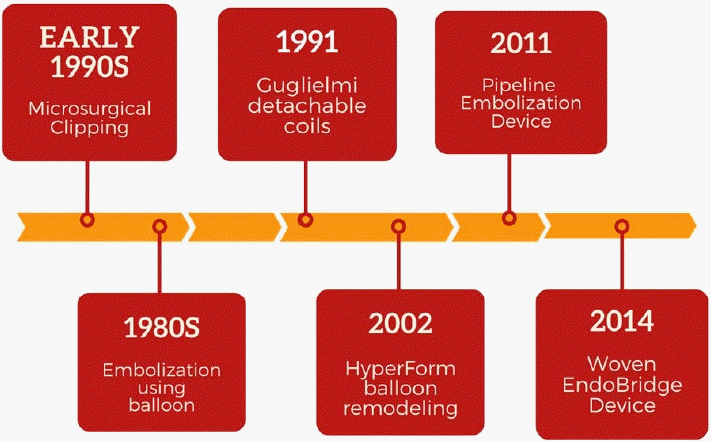
Table 1.
Summary of top 10 most cited studies on anterior communicating artery aneurysm
| Rank | First author | Year | Article title | Study design | Journal | CN | CY |
|---|---|---|---|---|---|---|---|
| 1 | Alexander MP [1] | 1984 | Amnesia after anterior communicating artery aneurysm rupture | Case series | Neurology | 242 | 6.54 |
| 2 | DeLuca J [13] | 1995 | Aneurysm of the anterior communicating artery: A Review of Neuroanatomical and NeuropsychologicalSequelae | Literature review | Journal of Clinical and Experimental Neuropsychology | 159 | 6.12 |
| 3 | Castro MA [6] | 2009 | Hemodynamic patterns of anterior communicating artery aneurysms: A possible association with rupture | Trial | American Journal of Neuroradiology | 148 | 12.33 |
| 4 | Gade A [18] | 1982 | Amnesia after operations on aneurysms of the anterior communicating artery | Prospective study | Surgical Neurology | 130 | 3.33 |
| 5 | Hernesniemi J [20] | 2008 | Microneurosurgical management of anterior communicating artery aneurysms | Case series | Surgical Neurology | 110 | 8.46 |
| 6 | Volpe BT [43] | 1983 | Amnesia following the rupture and repair of an anterior communicating artery aneurysm | Case series | Journal of Neurology, Neurosurgery and Psychiatry | 110 | 2.89 |
| 7 | Moret J [31] | 1996 | Endovascular treatment of anterior communicating artery aneurysms using Guglielmi detachable coils | Case series | Neuroradiology | 109 | 4.36 |
| 8 | Stenhouse LM [40] | 1991 | Long-term cognitive deficits in patients after surgery on aneurysms of the anterior communicating artery | Case series | Journal of Neurology, Neurosurgery and Psychiatry | 103 | 3.43 |
| 9 | DeLuca J [12] | 1991 | Confabulation following aneurysm of the anterior communicating artery | Case series | Cortex | 102 | 3.4 |
| 10 | DeLuca J [15] | 1993 | Predicting neurobehavioral patterns following anterior communicating artery aneurysm | Case series | Cortex | 98 | 3.5 |
Table 2.
Top 5 journals along with number of articles published, total citations and the impact factor
| Journal | No of articles | No of citations | Impact factor |
|---|---|---|---|
| Journal of Neurosurgery | 18 | 893 | 3.968 |
| American Journal of Neuroradiology Neurosurgery | 12 | 664 | 3.381 |
| Neurosurgery | 12 | 609 | 4.853 |
| World Neurosurgerya | 7 | 406 | 1.829 |
| Acta Neurochirurgica | 6 | 251 | 1.817 |




 PDF
PDF Citation
Citation Print
Print



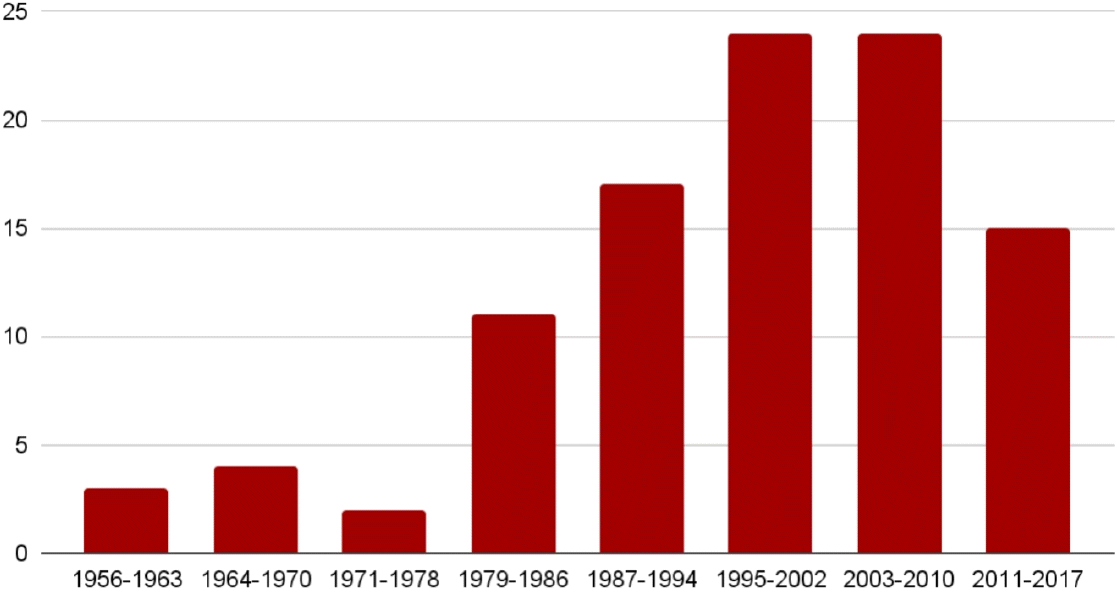

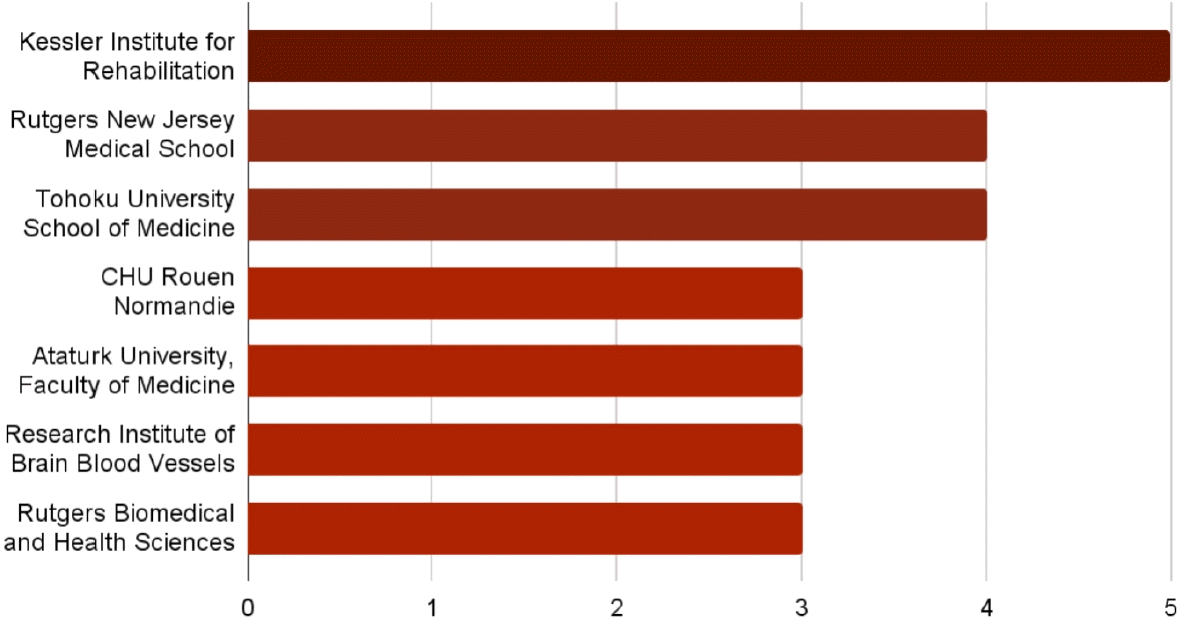
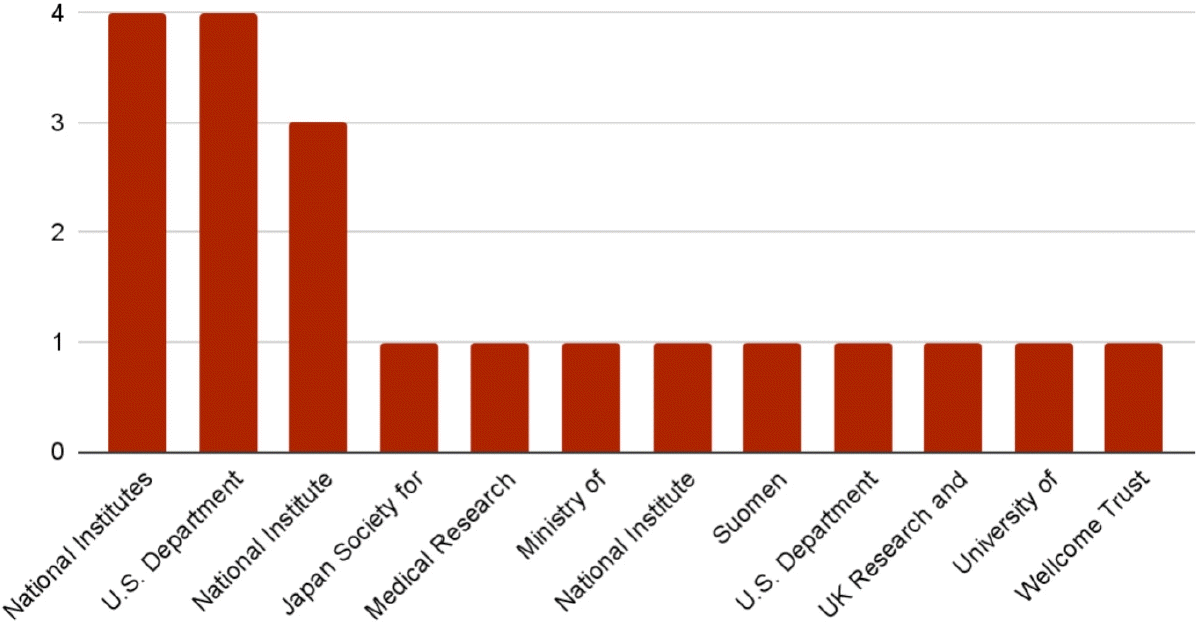
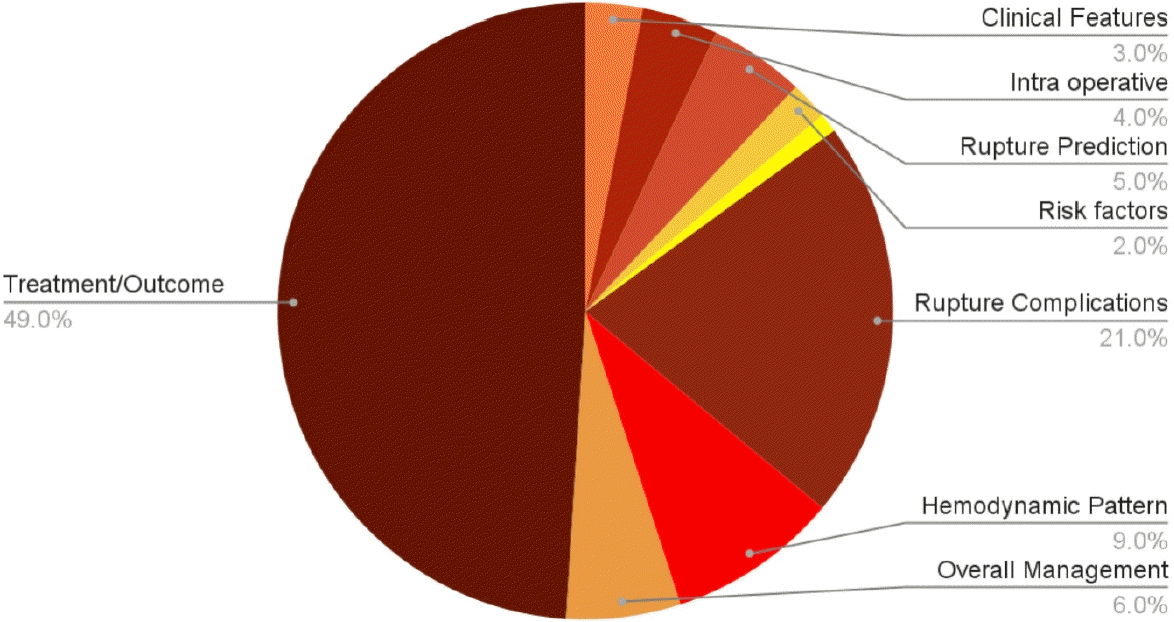
 XML Download
XML Download